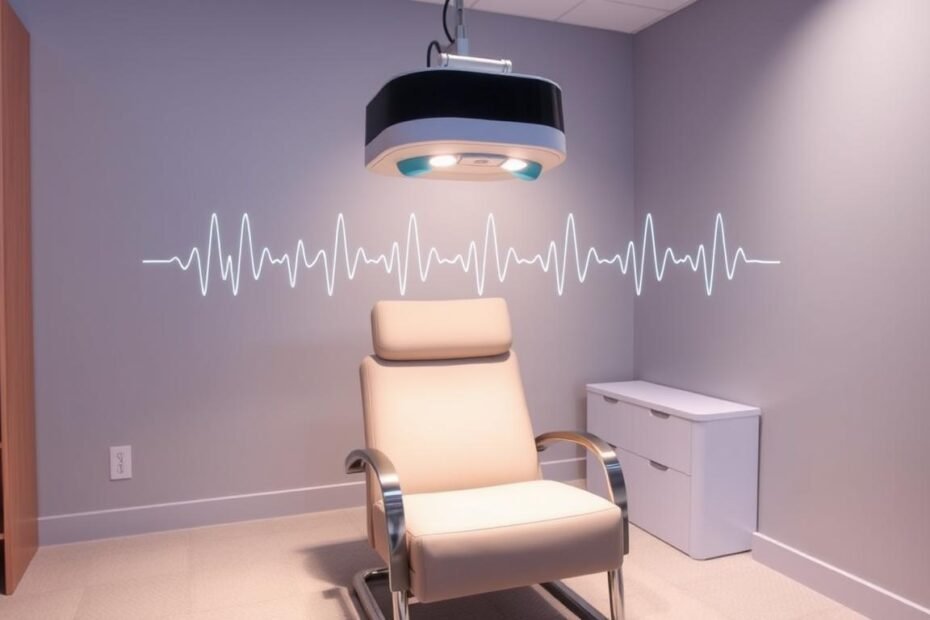TMS stands out in the world of mental health. It is a cutting-edge, non-surgical method that’s been making waves in treating depression. Using magnetic fields, TMS gets FDA approval for its power to energize brain cells12.It shines a light of hope for those who haven’t found help from usual treatments, especially with Major Depressive Disorder.
Beyond depression, TMS aids in easing Obsessive-Compulsive Disorder (OCD), migraine headaches, and helping people quit smoking2.This broadens its impact in mental health care. Individuals might get repetitive TMS (rTMS) for depression or OCD. They may also try faster, intense sessions for quicker outcomes. As such, TMS is evolving and proving to be a major player in combating depression1.
Key Takeaways
- Transcranial Magnetic Stimulation (TMS) offers a non-surgical approach to improving mental health symptoms.
- FDA-approved uses of TMS include treatments for Major Depressive Disorder, OCD, migraines, and smoking cessation.
- rTMS is particularly significant for managing depression and employs repetitive magnetic pulses.
- A typical TMS treatment for depression involves daily sessions across several weeks, with each session lasting from a few minutes to half an hour1.
- TMS is a safe option with most side effects being mild and temporary, but requires cautious consideration for those with certain medical conditions1.
- Ongoing research seeks to unveil more potential applications for TMS in mental health care and to enhance its efficacy.
Understanding Transcranial Magnetic Stimulation (TMS)
Transcranial Magnetic Stimulation (TMS) marks a major leap in non-invasive treatment for mental health issues. It is especially important for those with depression, OCD, and difficulty in controlling their moods. This approach boosts brain function and manages pain without surgery.
What is TMS and How Does It Work?
TMS uses electromagnetic coils placed on the head to send short magnetic pulses. It aims at the brain’s areas that handle mood and depression. These areas are stimulated, helping to reduce OCD and mood disorder symptoms. The FDA approved this technique in 2008 for patients who don’t get better with antidepressants3.
The Science Behind TMS
Research on TMS’s effect on mental health is uncovering hopeful results. It shows significant symptom relief and mood improvement. Many patients may see their symptoms lessen greatly after 10 to 15 TMS sessions4.
rTMS and other TMS methods change magnetic pulse settings to stimulate various brain areas. In 2018, the FDA also approved rTMS to treat severe OCD. This widened its use beyond just depression3.
Comparing rTMS and Deep TMS
| Treatment Type | Target Depth | FDA Approval | Primary Use |
|---|---|---|---|
| rTMS | Superficial brain layers | 2008 | Depression |
| Deep TMS | Broader and deeper brain areas | 2018 | Severe OCD |
rTMS mainly targets the brain’s surface, while deep TMS reaches further inside. Each method provides a unique range of stimulation. They both offer non-invasive treatments, focusing on the comfort and success of the patient’s healing journey.
Non-Invasive Brain Stimulation for Mental Health
Transcranial magnetic stimulation (TMS) is changing how we treat mental health. It uses magnetic fields to change how neurons work. This makes it a strong choice for many mental health problems without surgery.
First used in 1985, TMS has shown great promise in tackling tough depression cases. It works by changing brain activity with few side effects. Studies show it can help with more than depression. It’s useful for issues like thinking about suicide, quitting smoking, and fighting meth addiction5.
A lot of people with major depression have been helped by TMS6. The FDA gave it a thumbs up in 2008 for depression that doesn’t get better with medication5. Besides depression, TMS is also good for schizophrenia and OCD. This shows its wide range for mental health care7.
Looking ahead, there’s a goal to make TMS and other brain therapies even better. By focusing on each person’s unique situation, treatments can become more targeted. This could make TMS an even stronger option for those who haven’t found help elsewhere.
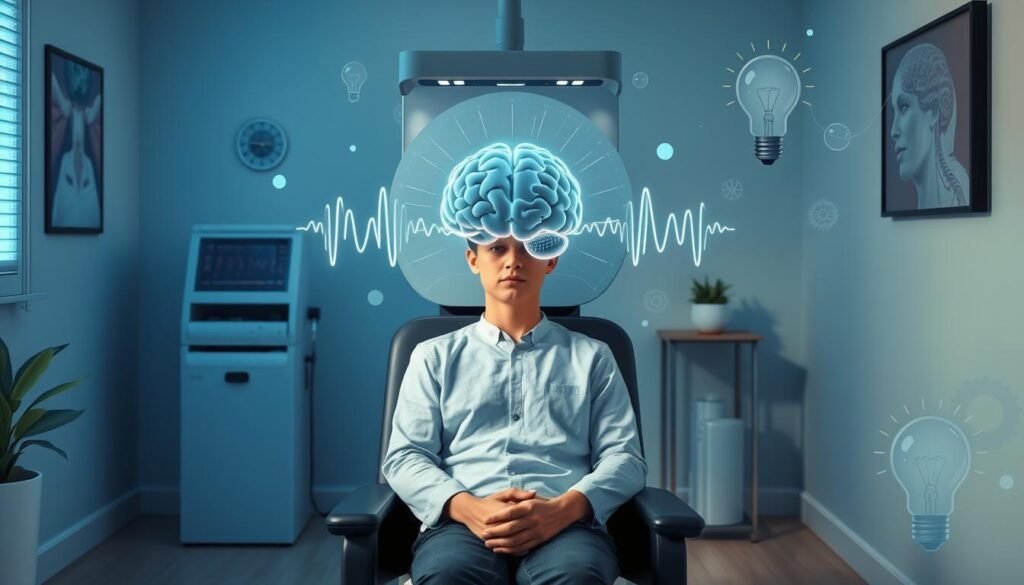
Continued research into brain stimulation is vital. As we learn more about the brain and mental health, TMS offers new ways to help. Its ability to improve lives without surgery keeps researchers and doctors excited about its future.
The Evolution of TMS: From FDA Approval to Current Applications
The story of Transcranial Magnetic Stimulation (TMS) is full of growth and wider acceptance. First approved by the FDA in 2008 for treating Major Depression, its uses have greatly increased. It’s now also used for things like OCD, migraines, and helping people quit smoking8.
TMS in Treating Major Depression
TMS is a beacon of hope for those with Major Depression, especially for those who haven’t found relief through medications. It needs a plan tailored to each person for the best results. High-frequency rTMS over a specific part of the brain has shown to greatly reduce depression symptoms9.
Expanding Use for OCD, Migraines, and Smoking Cessation
TMS doesn’t just fight depression; it’s making strides in treating OCD, migraines, and in helping people stop smoking. It shows great promise in OCD treatment, often outperforming other methods. It’s becoming a go-to for migraine relief, with specific plans to lessen their impact. For those trying to quit smoking, TMS offers a new door to freedom without relying on drugs9.
The growth of TMS’s uses shows us the power of understanding our brains better. It promises more healing methods and hope for the future of medicine.
Benefits of TMS Over Traditional Methods
In the world of mental health treatment, TMS stands out. It offers big gains over older methods like ECT and medications. Its safety, non-surgical nature, and success in treating depression make TMS a strong option in mental health care.
Safety and Tolerability of TMS Procedures
TMS is known for being very safe. It’s not like other treatments that need cuts or anesthesia. Because of this, both doctors and patients prefer TMS. Most people only face minor issues like headaches, which don’t last long1011. It’s rare to have severe side effects, making TMS a safe choice for many, even those who can’t go for traditional treatments10.
The Non-Invasive Advantage
The fact that TMS doesn’t require surgery is a big plus. It’s great for patients who didn’t do well with usual depression drugs. TMS targets specific brain areas to help fix mental health issues like depression and OCD without messing with the whole brain’s work1011.
TMS also means treatments can be more focused. This approach avoids the broad effects of drugs that impact the whole brain. For those fighting depression, this can mean big improvements in mental health without annoying side effects10.
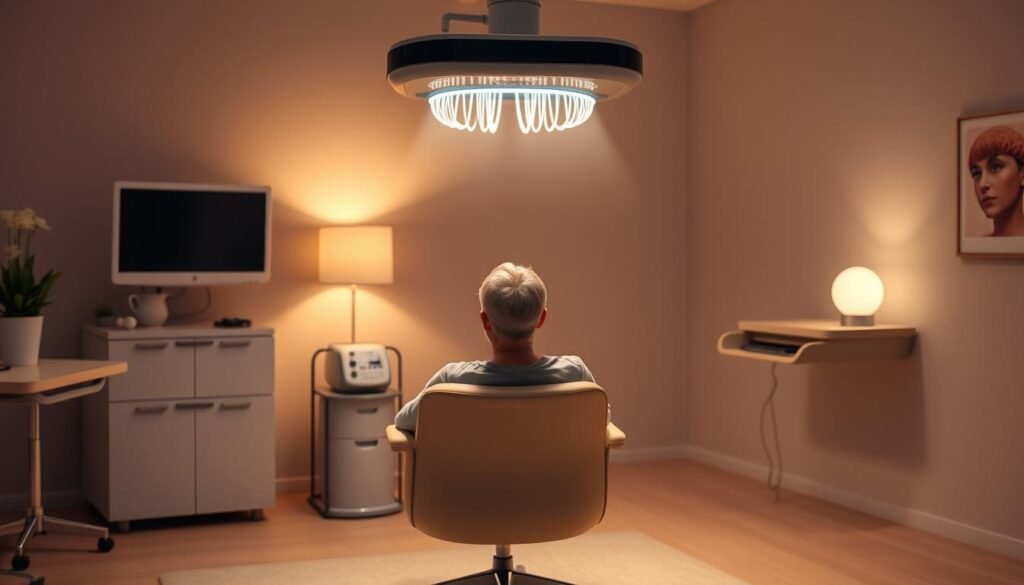
| Condition | Success Rate with TMS | Success Rate with Traditional Methods |
|---|---|---|
| Major Depressive Disorder | 30% – 64% | Varies, often lower |
| OCD | FDA Approved 2018 | Often inadequate response to SSRIs |
| Chronic Pain | Effective treatment; FDA approved 2013 | Variable efficacy of conventional treatments |
| PTSD | Effective by targeting the prefrontal cortex | Typically requires long-term medication/therapy |
TMS is a beacon of hope for those seeking non-invasive mental health care. It’s safer and more innovative than traditional options. For many, it opens the door to better mental health without the downside of more invasive procedures1011.
Risks and Side Effects of TMS Treatment
When looking into brain stimulation, it’s key to note that Transcranial Magnetic Stimulation (TMS) is mainly safe. But, it does have possible side effects and risks linked to treatment.
Mild to Moderate Side Effects
Some people might get headaches, seen in up to 6.9% of folks treated12, or discomfort where stimulated, in about 2.7% of cases12. You might also feel neck pain, toothache, or a tingling feeling, happening in roughly 4.7% of treatments12. Interestingly, while about 40% of patients have mild side effects, around 60% see a major decrease in symptoms13.
Using pain relievers and tweaking the stimulation can help ease these common issues. It’s crucial to keep an eye on patients and make changes when needed. This is particularly true for older individuals or those with severe depression, who might be more prone to side effects12.
Addressing Uncommon Severe Side Effects
More rare, yet severe issues can include seizures, with a chance of happening at 0.31% per 10,000 TMS sessions13. Other serious matters to consider are mood swings, changes in hearing if ear protection isn’t used properly, and even burns from the coil, though these are extremely rare12.
Especially risky groups, like those with non-removable metal in their heads, seizure history, or severe psychiatric conditions, should not get TMS13. Also, since drinking alcohol could increase seizure risk, it’s advised to not drink alcohol from five days before until the end of treatment13.
In short, while TMS is a hopeful option for those with hard-to-treat depression and other serious conditions, it’s important to be aware of possible side effects and risks. Making sure patients are thoroughly checked before treatment and watched by doctors afterwards is key. Research to make treatments better and safer is ongoing1213.
Eligibility and Preparing for TMS Therapy
Before trying Transcranial Magnetic Stimulation (TMS), it’s key to have a mental health evaluation. This ensures you’re a good fit for TMS eligibility. A doctor will look at your medical and psychiatric history carefully. They check for any issues that might conflict with brain stimulation. For those thinking about TMS, knowing the criteria and steps to prepare can really affect how well the therapy works and how safe it is.
Evaluating Medical and Mental Health History
Looking into a patient’s medical and mental health history is a big part of getting ready for TMS. Doctors do a detailed check to make sure there aren’t any problems that would stop a patient from getting TMS. It’s crucial to tell them about any neurological disorders, psychiatric symptoms, or past brain health problems. To be eligible for TMS, a patient must have tried at least two medications without enough success. Around 60% of such individuals respond well to TMS treatment14.
Using mindfulness and meditation techniques from skilled professionals can help get your mind and heart ready for TMS. These practices make you more open to the treatment.
Contraindications for TMS: When to Avoid It
It’s very important to know when brain stimulation isn’t a good idea. TMS isn’t suggested for those who are pregnant, have metal in their head, or have certain implants in their body. People with a history of seizures or severe mental health issues might also need to avoid TMS because of higher risks. Having metal dental work or other unremovable metal in the body might also stop you from using TMS15.
The safety of TMS therapy is well supported. It’s a procedure that doesn’t involve surgery, is FDA-approved, and has been researched for over 14 years14. Treatments usually last 30 minutes, done over six weeks, with five sessions each week15. This schedule helps get the best results while keeping an eye on any side effects like mild headaches or facial twitching15.
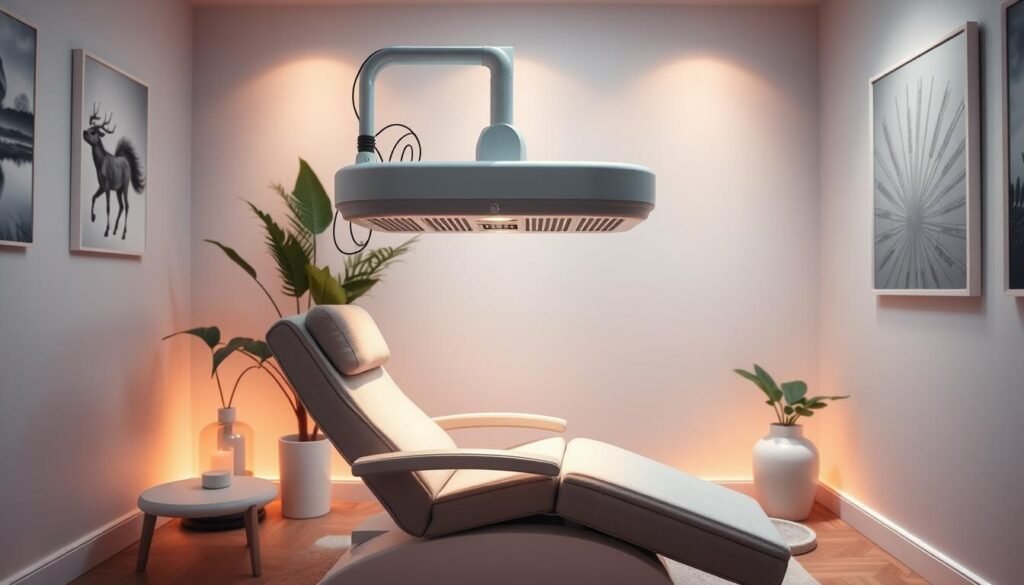
To sum up, to be ready for TMS eligibility, a detailed mental health evaluation and a clear understanding of contraindications for brain stimulation are needed. Anyone considering TMS should make sure they are well-informed and prepared for this promising mental health treatment.
The TMS Experience: What Patients Can Expect
When you begin Transcranial Magnetic Stimulation (TMS), it’s key to know what to expect. This includes understanding the TMS procedure experience, having clear TMS session expectations, and planning your post-treatment activities. TMS is a light of hope for those dealing with depression, OCD, and more, especially when other treatments haven’t worked.
Steps in the TMS Procedure
The process starts by figuring out the best brain areas for treatment. This first step can take 30 to 60 minutes, as it’s crucial for your later sessions16. After that, regular sessions last about the same time and feel like light taps on the head16. Thankfully, TMS is gentle enough that you can go back to your day right after a session.
During and After the TMS Sessions
TMS treatment usually takes 4 to 6 weeks, with sessions five days a week1617. Most people start to feel better within a few weeks, with many seeing major improvement or full recovery by week five18. TMS has shown great results for tough-to-treat depression and even works on OCD and certain neurological issues16.
After your TMS therapy, continue supporting your mental health. This means keeping up with therapy, following your doctor’s advice, and staying healthy. These steps secure the progress made with TMS.
In summary, TMS treatment is made to be smooth and straightforward, with potentially great benefits. Sticking to your sessions and following aftercare advice can significantly improve your life.
TMS Treatment Schedules and Protocols
The TMS treatment schedule and TMS protocols have changed a lot. They now use both old and new methods like theta burst stimulation to help different mental health issues. Adding repetitive sessions and new techniques has been key to making treatments better.
A usual TMS treatment phase means going every day, five days a week, for 4 to 6 weeks. This intense period is very important for managing symptoms in conditions like major depressive disorder19. Theta burst stimulation sessions are much shorter, around 3.5 minutes. This makes it easier for people to attend without losing effectiveness19.
When we look at TMS protocols, we see changes in how long and how often the sessions are: standard TMS sessions used to last up to 40 minutes. Now, with Theta Burst Stimulation, sessions are much shorter. This shows how treatments are getting more efficient without losing their power19.
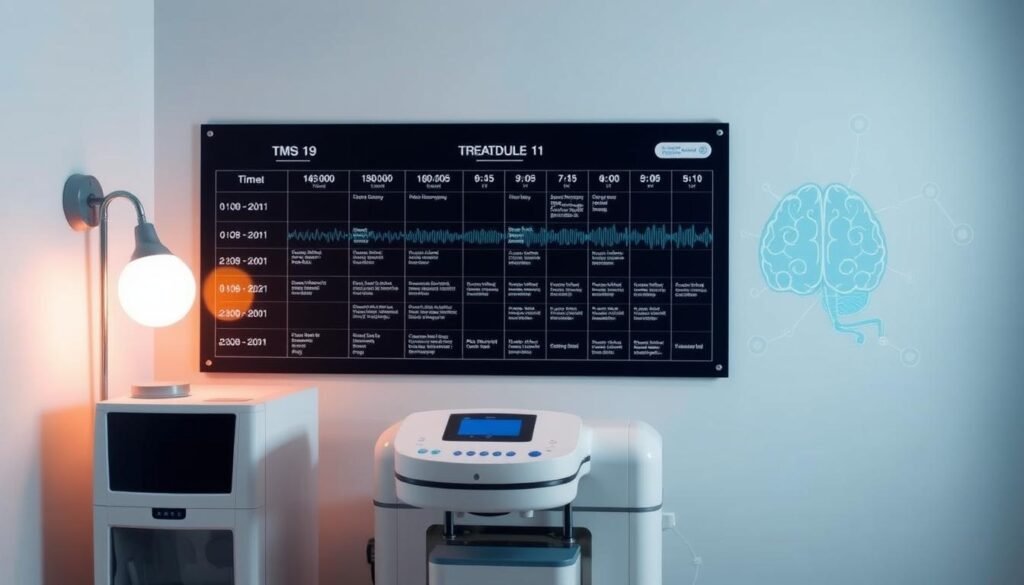
Studies back up these newer methods. They show a big jump in the use and study of TMS since 2000. Deep TMS and theta burst stimulation, especially, are getting more popular. They’re becoming a main part of treatment for many issues20.
Also, TMS is now being researched for treating things like addiction and dementia. This shows it’s useful for more than just a few conditions. There’s been a lot more talk and study about these new TMS ways in the last 20 years. This shows the field is growing and changing a lot20.
The safety of these treatments is still very good. Deep TMS can reach deeper parts of the brain safely. It does this without needing a stronger magnetic field, so it stays safe21.
Knowing all about TMS schedules and methods is very important for me. It helps me take care of my patients better. It also keeps me updated on new ways to help people with mental health issues. This ensures we use the latest science and treatments to help our patients.
Measuring the Effectiveness of TMS
TMS is a big deal because it offers a non-invasive way to tackle mental health issues. It’s super important to see how well TMS works. This helps us make treatments better and helps patients get well.
Assessing Improvement in Symptoms
Seeing if symptoms get better after TMS treatment is key. Research shows that rTMS really helps with depression, catatonia, and tinnitus. It can work when other treatments don’t.
22Imaging studies also support rTMS by showing changes in the brain after treatment. These changes match up with symptom improvement. This tells us TMS boosts brain health and helps fix its wiring22.
The Future of TMS Techniques
The future of TMS is looking bright. Scientists are working hard to tweak TMS to fit patients better. The FDA has already approved some new TMS methods. This is a big win for mental health care.
22Mental disorders are a huge challenge worldwide. Making TMS better can help lots of people. TMS has a big role to play in the future of mental health23.
TMS has the power to change mental health treatment for the better. By keeping track of how patients improve and following the latest research, we can make TMS help even more people. This could change the way we treat mental health issues.
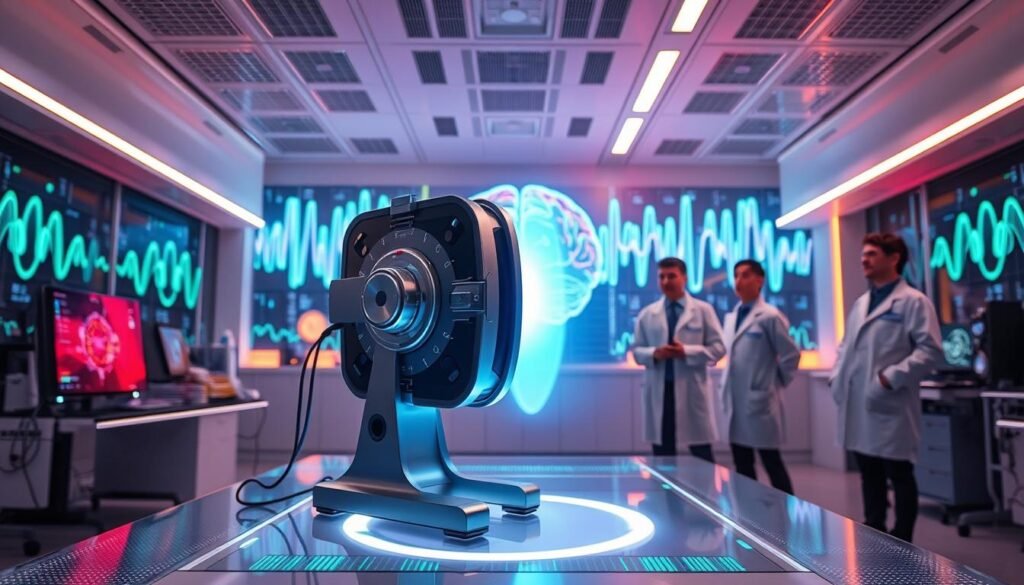
The path TMS is on could lead to treatments tailored for each person. This would be a big leap forward in understanding and treating mental health. With ongoing progress, we’re headed towards a future with better, more personalized mental health care.
Patient Stories: Personal Journeys with TMS
When we dive into TMS patient testimonials, we see the deep effect of this new treatment. Nikki’s story stands out. She battled for years but saw her mental health improve greatly after stopping her meds with TMS24. In just four weeks, her mood and outlook on life got much better24. This shows how real-world experiences with brain stimulation can help fight major depression.
Nikki felt a big change thanks to the caring team at BrainStim Centers. Their support was key to her success24. Many mental health recovery stories talk about how important a supportive environment is during healing24.
Stacy and Robert’s stories also highlight TMS’s power, even more when used with treatments like SPRAVATO®. Stacy saw big improvements in just three weeks, after years of struggling25. Robert also felt better in the same time, showing that new treatments can work when old ones don’t25.
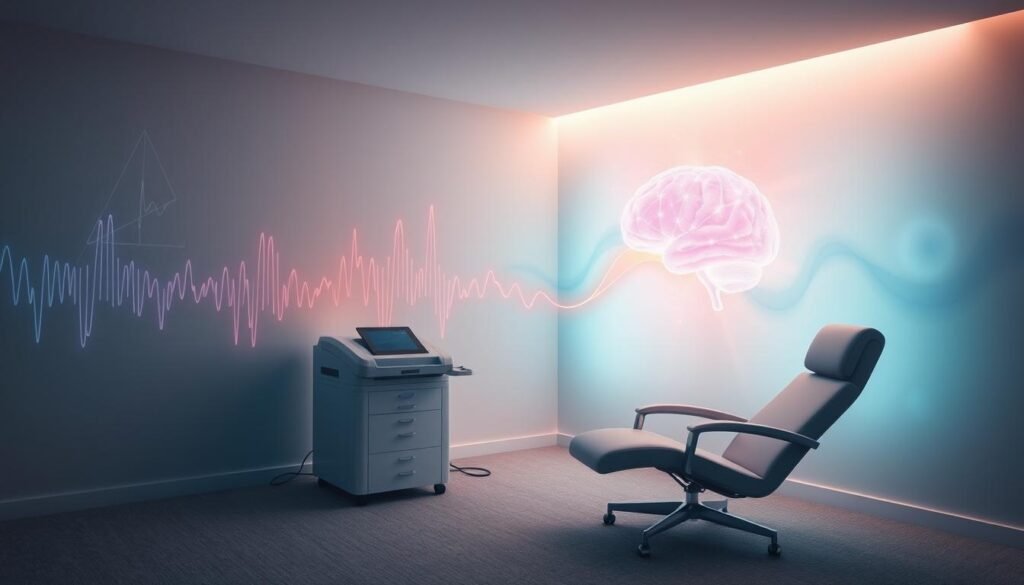 Data backs up success stories like Sano’s, who got better from CPTSD and depression. These stories show how TMS and treatments like SPRAVATO® can truly change lives for the better25.
Data backs up success stories like Sano’s, who got better from CPTSD and depression. These stories show how TMS and treatments like SPRAVATO® can truly change lives for the better25.
TMS has impressive success rates. About half of the patients see real improvement, and a third get completely better26. The future of TMS looks good, with changes that may lower costs and help more people26.
These stories give us a peek at how TMS and related treatments can greatly improve life. They also give hope to those still fighting with mental health issues. Sharing these TMS patient testimonials helps spread knowledge and hope about these advanced treatments.
TMS and Insurance Coverage
Getting TMS insurance coverage seems hard due to different rules from various providers. For many, knowing what’s covered and under which conditions helps figure out treatment affordability. Insurance for TMS therapy is more common now as it’s proven effective for major mental health issues like Major Depressive Disorder (MDD) and Treatment-Resistant Depression (TRD)27.
Healthcare coverage differs a lot among insurance companies. Some want a lot of proof of medical need. This includes showing past treatment failures with medications, as seen in recent updates from big health providers27. For instance, since October 2022, policies need proof of trying at least two different medications and specific depression test scores (HAM-D) to qualify27.
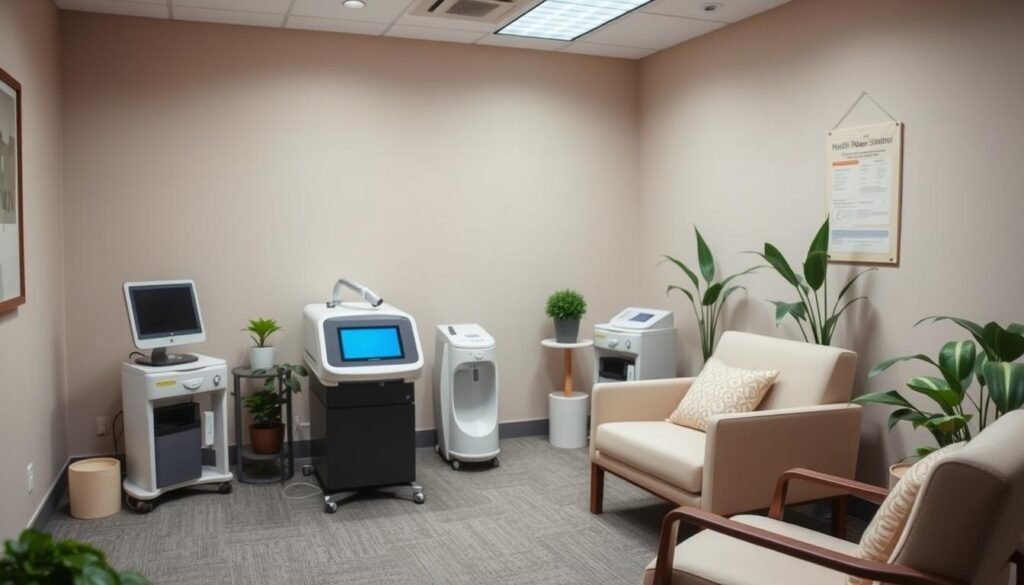
It’s key to understand how to work with insurance for TMS therapy. Insurers often ask for prior authorization. This means patients and doctors must show a full history of treatments and why TMS is needed27. Also, treatments for major depression are usually covered by insurance. But, how much is covered, like the number of treatments, can vary a lot28.
The direct costs of TMS therapy, like copays and deductibles, change based on your plan. Looking into payment methods and aid like healthcare financing can help manage costs27. Options like medical credit cards make TMS therapy easier to afford and lessen the financial stress, improving treatment affordability.
In the end, getting TMS insurance may seem complex, but with effort and a dedicated team, it can be done. This full approach not only makes healthcare coverage more likely but also lets more patients get this important treatment.
Maintenance Strategies Following TMS Treatment
Understanding TMS maintenance is key for anyone looking to manage mental health after treatment. Life post-Transcranial Magnetic Stimulation requires a plan to keep the benefits. Patients are advised to stick with treatments like medicine and therapy to keep up their progress29. This step is vital due to depression’s tendency to come back over time29.
Ongoing Care After TMS
The care doesn’t stop at the last TMS session. Keeping the improvements and avoiding steps back is crucial. The risk of falling back into old patterns makes it important to embrace a full care strategy30. This should cover both your body and mind. Experts who know the latest TMS and depression info help craft a care plan for lasting recovery.
When to Consider Repeat TMS Sessions
Thinking about more TMS sessions after the first set requires careful thought. Studies show that having maintenance rTMS sessions helps avoid future issues31. People who did well with TMS may feel better knowing maintenance can lower the chance of depression returning, compared to a 45-60% chance without it31. It’s a plus that insurance companies are starting to cover repeat TMS treatments. This helps patients keep benefiting from this safe therapy option.
FAQ
What is Transcranial Magnetic Stimulation (TMS) and how does it help with mental health?
Transcranial Magnetic Stimulation (TMS) is a way to stimulate the brain without surgery. It uses magnetic fields to wake up nerve cells in the brain. It helps when other treatments for depression don’t work. The FDA says it’s okay to use for OCD, headaches from migraines, and to help stop smoking. It can make the parts of the brain that control mood and depression work better.
How does TMS differ from other non-invasive treatments for mental disorders?
TMS doesn’t use surgery or drugs to help fix mood problems and mental health issues like OCD. It targets specific brain areas to make them work right without needing surgery. People generally handle TMS well and it doesn’t have big safety worries.
What are rTMS and Deep TMS? Are they different?
rTMS and Deep TMS are both TMS therapies but work differently. rTMS sends magnetic pulses to the top parts of the brain. Deep TMS goes farther, reaching deeper and wider areas of the brain. They both aim to change how the brain works to help you feel better.
Is TMS an FDA-approved treatment?
Yes, the FDA has approved TMS for treating major depression. This approval now includes treating OCD, helping with migraine pain, and helping people quit smoking. This shows more and more people believe TMS works for many mental health problems.
What are the primary benefits of TMS compared to traditional mental health treatments?
TMS is great because it doesn’t involve surgery or drugs. It has few side effects and doesn’t need you to be asleep or take medicine. It’s especially good for people who haven’t gotten better with other treatments for depression.
Are there any side effects associated with TMS treatment?
Some people might get headaches or feel a bit dizzy. There might be a little discomfort on the scalp or twitching in face muscles. But these usually don’t last long. Very rarely, it can cause seizures or manic episodes, but this is uncommon.
Who is eligible for TMS therapy?
Doctors decide if you can have TMS by checking your health closely. This might include checking your body and doing lab tests. If you have metal in your head or some other medical devices, or a history of serious health issues, TMS might not be for you.
What should a patient expect during a TMS procedure?
You’ll sit in a comfy chair, and a coil goes near your head. You’ll feel a gentle tapping. The first time takes around an hour, but later visits are shorter. You go five times a week for 4-6 weeks but can do your normal things afterward.
How are the results of TMS measured?
Doctors look for fewer signs of depression or other mental health issues. Changes usually start after several weeks. In some cases, the problem goes away completely.
What does post-TMS maintenance look like?
After TMS, you keep going with regular care like medicine and therapy. You might come back for TMS now and then, or if the problem comes back.
Is TMS therapy covered by insurance?
Insurance may or may not cover TMS. They’re more likely to help pay for it if medicines haven’t worked for your depression. Paying for OCD treatment or help quitting smoking might be harder and depends on your insurance and if it’s really needed.

